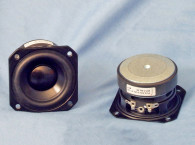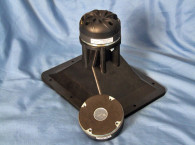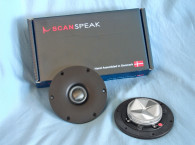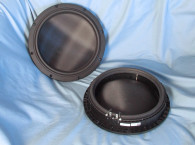

Features for the GBS-135F25AL02-04 include a four-spoke stamped steel frame with a mere 27.4 mm (1.08”) total depth. The depth is significant as the motor assembly is obviously housed inside the frame (see Photo 2). This motor assembly uses a ferrite magnet that measures 80 mm × 15 mm with a T-yoke that has an 8 mm diameter pole vent. Photo 1 shows the area below the spider is completely open and allows air to circulate across the top plate although not the voice coil winding. The cone assembly is comprised of a flat cone made from a convex 90 mm diameter aluminum dome. Suspension is provided by an inverse roll NBR (CBR) surround and a single 90 mm diameter cloth spider. The patent application also designates models that use a dual-spider configuration. Total depth, including the aluminum dome/cone is 44.9 mm (1.76”). Last, the cone assembly is driven by a 1” (25.5 mm) diameter two-layer voice coil wound with round copper wire on an aluminum (ASV) former, terminated to a pair of solderable terminals.
I commenced analysis of the GBS-135F25AL02-04 using the LinearX LMS analyzer and VIBox to create voltage and admittance (current) curves, with the driver clamped to a rigid test fixture in free air at 0.3, 1, 3, 6, and 10 V. I had to discard the 10 V curves as they were too nonlinear for LEAP Enclosure Shop to get a good curve fit. The reason for this is that the LEAP 5 LTD transducer model methodology results in a more accurate prediction of excursion at high voltage levels, which is one of the real forte’s of the LEAP 5 software used in conjunction with the LinearX VIBox.


I use the actual measured cone assembly mass (mmd) supplied by the driver manufacturer, which was 11.8 grams for this Tymphany 5.25” woofer. Next, I post processed the eight 550-point stepped sine wave sweeps for each GBS-135F25AL02-04 sample and divided the voltage curves by the current curves (admittance) to derive impedance curves, phase added by the LMS calculation method. I imported the data, along with the accompanying voltage curves, to the LEAP 5 Enclosure Shop software.
I additionally created a LEAP 4 TSL parameter set using the 1 V free-air curves (see Figure 1). I selected the complete data set, the multiple voltage impedance curves for the LTD model, and the 1 V impedance curve for the TSL model in the transducer derivation menu in LEAP 5 and created the parameters for the computer box simulations. Table 1 compares the LEAP 5 LTD, TSL and factory published parameters for both samples.
The LEAP parameter calculation results for the Tymphany GBS-135F25AL02-04 were close to the published factory data, except for a slight difference in the Sd and the 2.83 V/1 m sensitivity. The Sd I used included 50% of the surround, which was 10.3 cm for the diameter. Tymphany’s spec is based on a more liberal 10.5 cm, which is not significant and does not account for the difference in sensitivity. Following my protocol for Test Bench testing, I set up computer enclosure simulations using the LEAP LTD parameters for Sample 1. I programmed two computer box simulations into LEAP 5. The first simulation was a sealed enclosure with a 0.24-ft3 volume with 50% fiberglass fill material.



The second simulation was a Chebyshev/Butterworth vented alignment in a 0.38-ft3 volume tuned to 50 Hz with 15% fiberglass damping material. Figure 2 shows the GBS-135F25AL02-04’s results in the sealed and ported boxes at 2.83 V and at a voltage level sufficiently high enough to increase cone excursion to 3.8 mm (XMAX + 15%). This produced a F3 frequency of 69.5 Hz (F6 = 52 Hz) with a QTC = 0.7 for the sealed enclosure and -3 dB = 54.4 Hz (F6 = 45 Hz) for the vented alignment.
Increasing the voltage input to the simulations until the maximum linear cone excursion was reached resulted in 95 dB at 6 V for the closed box enclosure simulation and 97 dB for the same 6 V input level for the larger vented box. Figure 3 shows the 2.83 V group delay curves. Figure 4 shows the 6 V excursion curves. Note that because the vented box example reached 4 mm of excursion at about 35 Hz, so adding a steep 24 dB/octave high-pass active filter located about 25 to 35 Hz would prevent over excursion and distortion for vented box example by a substantial margin.




Klippel analysis for the GBS-135F25AL02-04 produced the Bl(X), KMS(X) and Bl and KMS symmetry range plots given in Figures 5–8. (Our analyzer is provided courtesy of Klippel GmbH and Patrick Turnmire, of Redrock Acoustics, performed the analysis.)
Figure 5 shows the Bl(X) curve for the GBS-135F25AL02-04 is very symmetrical and fairly typical for a short XMAX driver. Looking at the Bl symmetry plot (see Figure 6), this curve shows a fairly small 0.7 mm coil-out offset once you reach the area of high certainty (around 3 mm of excursion), which remains constant throughout the operating range, so is probably just slightly off magnetic center.
Figure 7 shows the KMS(X) curve. Figure 8 shows the KMS symmetry range. The KMS(X) curve is definitely not as symmetrical in both directions as the Bl curve, but shows a forward bias coil-out offset that gets to about 2 mm at the physical XMAX position. This does not create a subjective problem and like guitar speakers with a small forward bias, produces some “warm” sounding second harmonic distortion. I suspect this is an aspect of the unique suspension system and how the parts are located.
The GBS-135F25AL02-04’s displacement limiting numbers, calculated by the Klippel analyzer, were XBl at 82% Bl = 3.3 mm and for the crossover (XC) at 75% CMS minimum 3 mm, which means that for the GBS-135F25AL02-04, the compliance is slightly more limiting factor for prescribed distortion level of 10%.






Figure 9 gives the GBS-135F25AL02-04’s inductance curves Le(X). Inductance typically increases in the rear direction from the zero rest position as the voice coil covers more pole area, which is what happens here. However, the inductive swing is small, 0.18 mH from the rest to the XMAX coil-in position, and 0.19 mH from the rest position to the 3.3 mm XMAX coilout position.
Next, I mounted the GBS-135F25AL02-04 in an enclosure with a 14” × 6” baffle area and was filled with damping material (foam) and then measured the device under test (DUT) on and off axis from 300 Hz to 20 kHz frequency response at 2.83 V/1 m. Figure 10 shows the on-axis response indicating a fairly flat ±2.25 dB response to about 2.5 Hz with a 7 dB peak at 3.4 kHz, where it begins its low-pass roll-off.
Figure 11 displays the on- and off-axis frequency response at 0°, 15°, 30°, and 45°. Figure 12 shows the normalized response. Figure 13 shows the CLIO polar plot. Given the peak at 3.4 kHz, I wouldn’t cross this driver any higher than 2 to 2.25 kHz. And finally, Figure 14 gives the two-sample SPL comparisons, showing a reasonable 0.5 to 1 dB match throughout the operating range.



For the remaining tests, I used the Listen SoundCheck software, SoundConnext analyzer, and SCM microphone to measure distortion and generate time-frequency plots. For the distortion measurement, I mounted the GBS-135F25AL02-04 in free air and used a noise stimulus to set the SPL to 94 dB at 1 m (7.58 V). I measured the distortion with the Listen microphone placed 10 cm from the dome’s center, which produced the distortion curves shown in Figure 15.
Next, I used SoundCheck to get a 2.83 V/1 m impulse response and imported the data into Listen’s SoundMap Time/Frequency software. Figure 16 shows the CSD waterfall plot. Figure 17 shows the Wigner-Ville plot. Overall, the GBS-135F25AL02-04 delivers good performance from a 5.25” midbass driver, especially one that is only 1” deep! For more information, visit www.tymphany.com. VC
This article was originally published in Voice Coil, September 2016.







